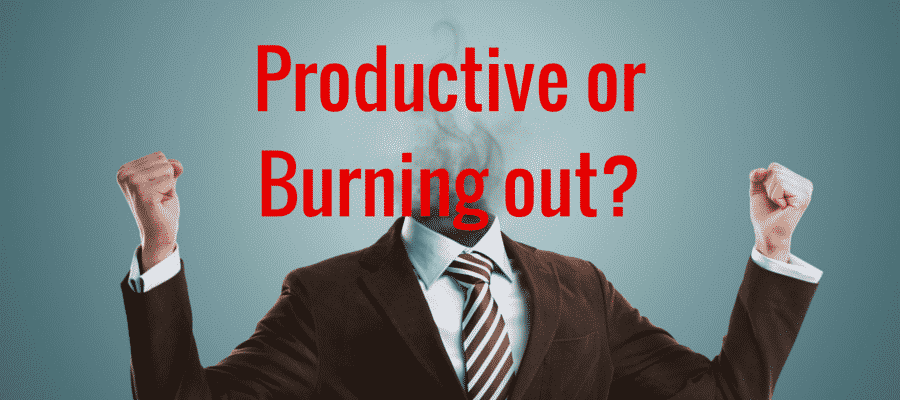
Jul 8, 2016
Are you super productive or on the fast lane to burnout?
Even though average working hours per year keep going down across the industrialised world some professions, like IT consulting, seem to demand higher and higher workloads to be completed within given time frames, and these time frames are measured in “project time”, not a five-day workweek regulated by fair work contracts. That is why being productive is essential in IT.
While there are people who enjoy the pressure and gladly submit to project time, there are many who suffer, or are simply drifting towards the flaming pits of burnout without noticing what’s going on, instead blaming the warning signals from their bodies and minds on a “flu” or only “stress”.
How do you know if the high-pressure job you (used to) enjoy is not taking you over the edge in the long run?
More importantly, what can you do about it? How can you stay productive in a sustainable way?
It’s simpler than you think, as long as you ask yourself the right questions and take the right actions.
Burnout happens for any of this three reason:
1. No outcomes
2. Misalignment to outcomes
3. Busy, busy, busy
Do you know where you’re going?
When you think about everything you expect to accomplish, do you see clear directions or a painting that should be hanging in the Museum of Contemporary Art (open for interpretation)?
In other words, is it clear to you which outcomes you will be producing in the course of your day and week and how these contribute to the greater good of your team, your project and the organisation you are part of?
If what you’re doing at work doesn’t have clearly defined outcomes you’ll end up feeling like a hamster in his little wheel – running without getting anywhere. The hamster usually doesn’t mind because he can get off anytime, but what about you? Sounds tiring, doesn’t it?
1st Productivity Action
Here’s your first course of action to ensure sustainable productivity and avoid burnout: whenever you do anything, be clear on the outcome and how it fits into the bigger picture.
If you’re not, stop and think, and if that doesn’t help ask!
Having clearly defined outcomes in your work is the foundation stone everything else rests on. Better to spend some time on this before you start chipping away at the old block – it’s the biggest ROI you can get.
Is what you do important to you?
So you’re getting into your work now because you made sure that all your outcomes are clearly defined, and you’re flying through your tasks, churning through them like a combine harvester through a wheat field, but you can’t shake that nagging feeling of “really, who cares?”
You’re getting stuff done, and your colleagues and your boss are impressed, but somehow it’s all rather unexciting, like a glass of warm milk at the end of a football game?
Are all these “important” things you’re getting done not so important to “you”? Do you fail to see what your boss seems to see in the weekly progress meetings? Not quite sure why you’re even there?
There’s a whole lot to say about your motivation and what drives you at work (click here for an earlier blog post about just this topic), but in the context of burnout it’s all about “alignment”.
If what’s important to “you” in your work, is not aligned with the outcomes you are expected to produce then you’ll be sailing your boat against a strong headwind. You’ll arrive late, after a much more challenging journey, or in the wrong place.
If you want smooth sailing towards your outcomes, you have to be confident that your values are pointing in the right direction and are driving you towards your outcomes. They should not be pushing you away from them (click here if you would like to watch a video with Alice taking you through her Values Alignment Map, showing you how to make sure that your values are aligned with your outcomes).
2nd Productivity Action
Here’s your second course of action to ensure sustainable productivity and avoid burnout: ask yourself “What’s important to me in the context of my work?” and write down whatever comes to mind. Then highlight the top five in that list, and cross-checks them against the outcomes you are expected to achieve. Are your top five values driving you towards your outcomes or away from them?
If any of your values are not helping you achieve your results, write down how they can be tweaked, or fine-tuned, adjusted to change that, or if how you can go about working towards them differently, in ways that create greater alignment (or watch a video with Alice taking you through a powerful process that helps you with this).
Are you too busy?
Burnout happens too when you’re busy, busy, busy, filling your time with whatever comes across your desk or Inbox without prioritising or putting what you do into the context of the expected outcomes (see above).
You keep your engine running at top revs and in no time you run your adrenals flat because of the constant negative stress which is caused by anxiety (“Am I doing this right?”), fear (“What will happen if I get this wrong?”) and anger (“Damn these idiots who don’t do their job properly!”)
Burnout people are focusing on getting things right, and are worried they don’t. Often they don’t have any standards for what they’re doing, no means of determining if they’re on the right track.
3rd Productivity Action
Here’s your third course of action, in three parts, to ensure a productive outcome and avoid burnout. Assuming you know your outcomes and how they are important to you (see the productivity actions 1 and two above) make sure you:
- Have criteria to determine if you have completed a task to the required standard. Know in advance when your work will be done, and remember: “Perfect is (often) the enemy of getting it done!”
- Prioritise everything! We all have a tendency to do the natural items on our list first because like all inhabitants of the animal kingdom we like to be lazy when we can (That doesn’t apply to you? Good on you!). The problem with this approach is that we might get lots done early on, but we’ll end up like students the night before an exam, trying to cram everything (in this case all the “hard” stuff) into the very limited remaining time. Do the tasks which you haven’t done before and which require your creative, analytical and problem-solving skills first, because at the start of the day your body and mind are still fresh, and you’ll cruise through the easy stuff later. As Brian Tracy put it in one of his books: “Eat that Frog!”
- Plan your day and week. Make sure there are time slots for everything you intend to accomplish, including coffee breaks with your colleagues and dinner with the family. Then stick to it. Admittedly not a perfect approach because there’s always the unexpected. Just keep in mind what President Eisenhower said in a National Defense speech in 1957: “Plans are worthless, but planning is everything!”
Sustainable Productivity vs. Burnout
As I stated in the beginning, it’s “simple” to be productive in a sustainable way. Just follow the three productive actions described above, or if you’re hard pressed for time because you are busy, busy, busy, and don’t know where to start or to get to then consider this nutshell:
Productive people focus on getting the right things done at the right time to the right standard.
They’re clear on their outcomes, and they do work that is important to them personally.
They schedule their time and plan their tasks well.
Amen.
Alice Haemmerle, on whose knowledge and experience as an executive coach and Master Trainer of Neuro Linguistic Programming this blog post is based on, is the creator of the Instant Insight Communication Systems (coaching systems using the different filters and internal strategies that are in play when we work, communicate and relate to each other) and The Communication Code™ (showing you how to decode someone’s communication, motivation, decision making and problem solving styles).
Her husband, Thomas Haemmerle has written this post.







